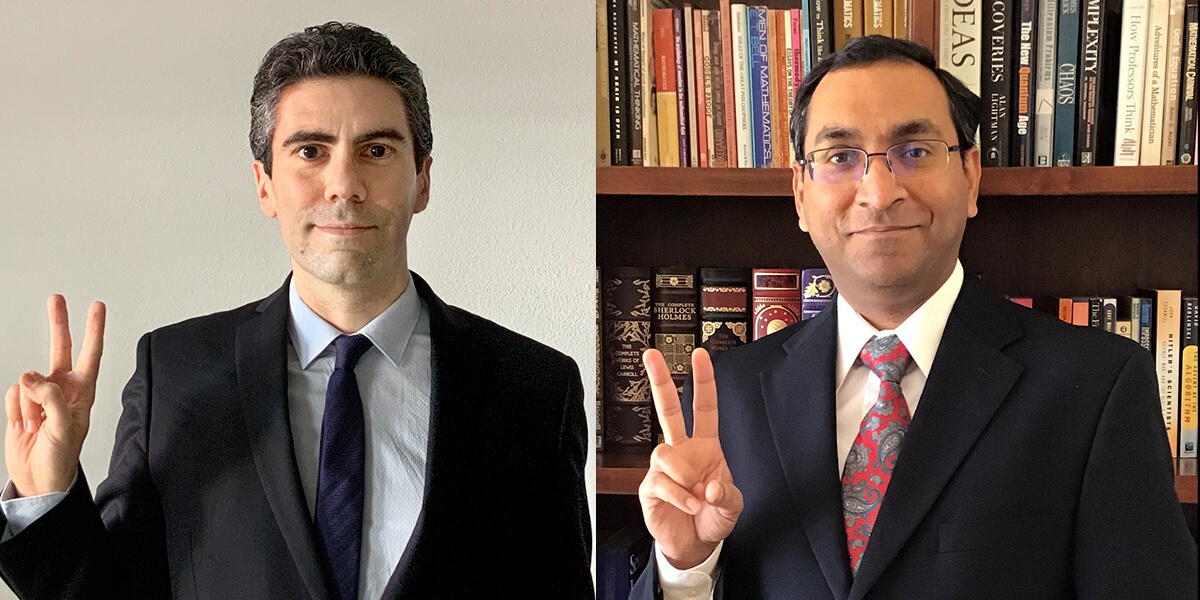
Professors Pierluigi Nuzzo (left) and Rahul Jain will be conducting research to improve testing and training of AI. (PHOTO CREDIT: USC Viterbi).
There is a term in systems engineering known as the big “V”; And no, it has nothing to do with the USC “V for victory” two-fingered salute.
Engineers often split a complex system into sub-systems, design and code for each component sub-system, and then test and put them all together to verify and validate the entire design against the requirements and the user needs. The down line of the V is decomposition, and its up line is integration. This tried and true method has proven successful when we have a good understanding of the components and their interactions. But many sub-components in today’s systems rely on artificial intelligence and neural networks. They are more like black-boxes with limited “interpretability.”
Rahul Jain, the Kenneth C. Dahlberg Early Career Chair, and Pierluigi Nuzzo, both professors in the USC Viterbi School of Engineering’s Ming Hsieh Department of Electrical and Computer Engineering and co-directors of the USC AutoDrive Lab, are taking that “V” concept, tweaking it, and applying it to their work in electrical and computer engineering.
“Electrical and computer engineers have to worry not only about making things work but proving that they will work the way they were designed to in varied real-world environments.”
– Professor Rahul Jain
The two have just been awarded a grant from the Office of Naval Research’s competitive Science of AI program to analyze a complex system that incorporates AI components. By using the principles of compositionality they seek to prove that the overall system will meet safety-critical and mission-critical specifications and achieve the performance objectives. Or in simpler terms, “Fold the V” to guarantee safety and performance with AI components. So what does “Folding the V” mean, exactly?
Consider the example of autonomous vehicles, which are complex systems comprised of many sub-systems. Some of these sub-systems, like the perception system, have AI components. It is not enough to be able to say that the perception system will recognize a red light with high accuracy. When the perception system is put in the control loop, the vehicle must actually come to a stop at a red light.
But if testing and verification are done individually for each sub-system, it may not translate into the whole system working as desired. For complex systems like this, we must be able to efficiently test and verify the entire system. Instead of validating the whole system at the very end and then having to retrace your steps when you find a mistake, you can verify many aspects of the system individually along the way and know they will work when put together. It’s as if the down line of a V (decomposition, or development), and the up line (integration, or verification), have been folded onto each other. That is what “Folding the V” seeks to do – ensure all the complex sub-systems can be conceived and designed such that they will work with each other before they are actually combined.
“Some systems may not be able to correctly operate in an unstructured and unpredictable environment without the help of AI and neural networks, but including these components in the system also makes it harder to provide assurance on the overall system behavior,” says Nuzzo. In other words, the very nature of extremely complex autonomous systems makes the traditional “V” approach unscalable, with the risk of being unsuccessful. That’s why Jain and Nuzzo are trying to fold it instead.
This is a challenge that simply must be solved to efficiently build important systems that rely on artificial intelligence. One might understandably ask why it’s two electrical and computer engineers who are leading this project.
“Electrical and computer engineers have to worry not only about making things work but proving that they will work the way they were designed to in varied real-world environments,” said Jain.
The duo’s electrical and computer engineering background helps them solve problems from concept to implementation. This line of thinking, which combines broad engineering training with a practical mindset focused on the final product is what makes electrical and computer engineers well suited to solve these big challenges.
Published on May 26th, 2020
Last updated on May 26th, 2020










